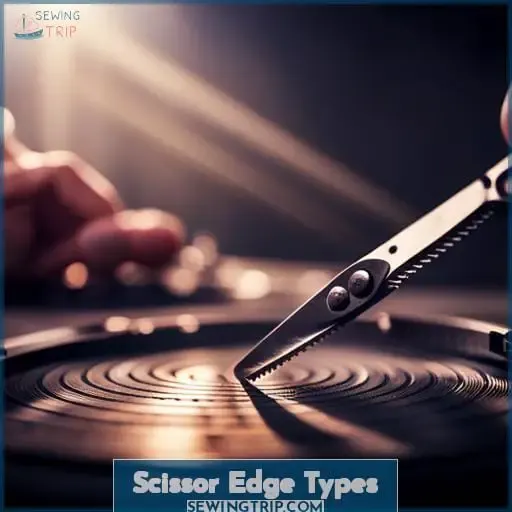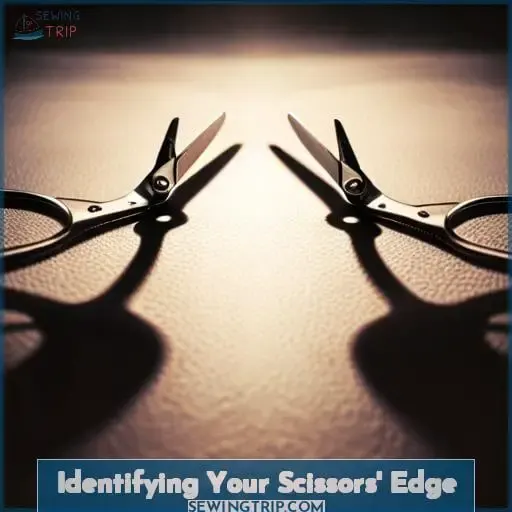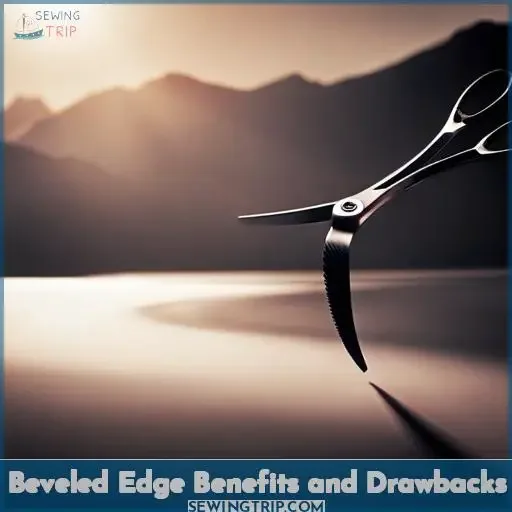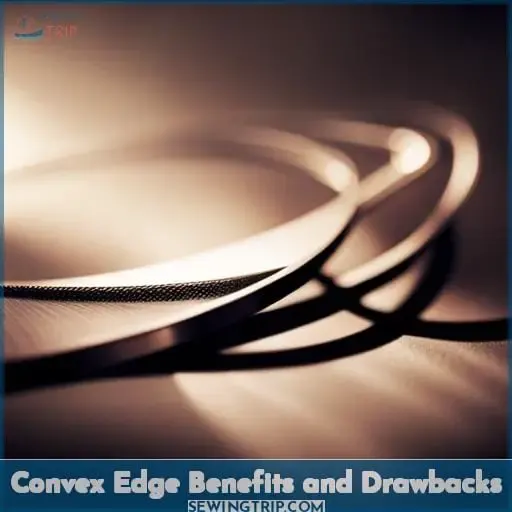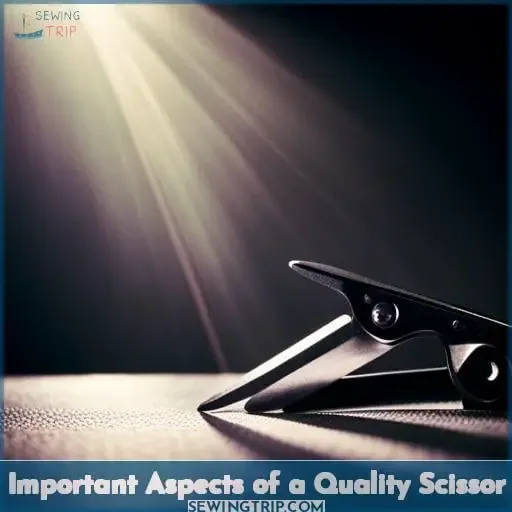This site is supported by our readers. We may earn a commission, at no cost to you, if you purchase through links.
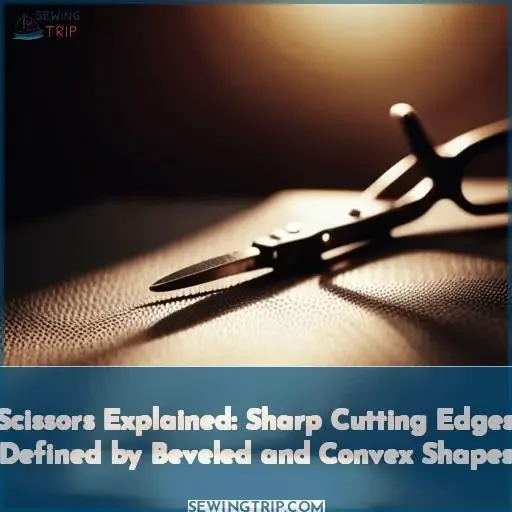 Picture a world where fabrics meet their match in sharp edges.
Picture a world where fabrics meet their match in sharp edges.
Scissors, with their beveled and convex shapes, stand as masters of precision cutting.
These intricate tools shape our creations, bringing ideas to life.
In this article, we’ll delve into the world of scissors, exploring the fascinating details of their edges.
We’ll dissect the benefits and drawbacks of beveled and convex edges, arming you with the knowledge to make informed decisions when choosing your next pair of scissors.
Table Of Contents
Key Takeaways
- Scissors come in different edge types like beveled, convex, serrated, and semi-convex, each with their own benefits and drawbacks.
- Identifying scissor edges involves looking at factors like the width and angle of the blade junction, sharpness, smoothness, and the presence of tiny serrations.
- Beveled scissor edges cut precisely but dull fastest, requiring frequent honing. Convex edges enable smooth, effortless cutting but chip easily and need frequent sharpening.
- Quality scissors depend on aspects like steel grade and composition, manufacturing method, special treatments, cobalt content, terminology like honing and bevel angle, etc.
Scissor Edge Types
As you inspect your scissors’ blades, you’ll notice distinct edge shapes that greatly impact performance.
Key edge types include:
- Affordable yet blunt beveled edge
- Ultra-sharp convex edge perfect for detail work
- Grippy serrated blades that snag hair
- Versatile semi-convex cutting surfaces balancing strength and precision
Making small changes to a scissor’s honed cutting angles and curvature transforms handling, so edge selection suits your clients’ needs.
Beveled Edge
Your beveled edge’s basic design makes affordable, easily sharpened shears for simple cuts.
Though less durable than convex designs, their precision beveled blades offer decent sharpness for basic cutting techniques without the expense of more advanced edges.
However, convex edges provide superior sharpness and durability despite cost and sharpening difficulties.
Serrated Blade
With its tiny, thin, fine lines cut into the cutting edge blade, the serrated blade holds hair better and prevents slipping while being used for scissor over comb or straight, blunt bobs.
Convex Edge
Frequently, you’re cutting with the sharpest, smoothest scissor edge.
The convex edge offers precision crafting for various cutting techniques.
Edge longevity and maintenance can be concerns with the delicate precision designs.
| Durability | Sharpness | Cost |
|---|---|---|
| Lower | Higher | Higher |
| Prone to chipping | Excellent slide cutting | Expensive materials and crafting |
| Fragile at tip | Smooth cuts | Investment for professional use |
| Needs frequent sharpening | Ideal sharp point | Not a budget option |
Semi-Convex Edge
You’ll find semi-convex edges combine attributes of beveled and convex shapes for well-rounded performance.
- Durable yet precision-honed cutting edges
- Balanced sharpness and smooth operation
- Reduced maintenance requirements
- Quality materials and workmanship
- Best of both beveled and convex worlds
Identifying Your Scissors’ Edge
After detailing scissor edge types, you’re ready to identify your own scissors’ cutting edge by looking closely at the blade’s shape near the tip.
Grab your shears and inspect where the two blades meet.
A beveled edge has a wider, flatter junction before tapering while a convex edge curves inward to a sharper point.
Run your thumb along the intersection.
A convex edge feels smooth and sharp while a beveled edge is slightly rounded on the edges.
Tilt the blades to catch the light.
A beveled edge shows a broader, duller wedge shape compared to a convex edge’s narrower, more angled profile.
Knowing your scissors’ edge type guides optimal usage and care.
Beveled edges suit basic cuts but require frequent honing.
Delicate convex edges excel at detailed work yet demand gentle handling.
Proper identification sets clear expectations for cutting performance, sharpness retention, and ideal maintenance to maximize your investment.
Beveled Edge Benefits and Drawbacks
You get sharp but quickly dulling edges with the beveled style.
This affordable edge works well for basic cuts yet lacks strength for advanced techniques requiring more blade force.
Expect to trade sharpness maintenance for cost savings when selecting these entry-level shears.
Sharp But Dulling Quickly
Despite staying sharp initially, you’ll find a beveled edge loses its cutting ability faster than other styles.
- Requires frequent honing to maintain sharpness.
- Prone to nicks and dulling from bone or sinew.
- Gains micro-serrations without care.
- Needs professional sharpening services.
- Avoid cutting tough materials lacking convex support.
Great For Basic Cutting
One can still get sharp, precise cuts with a beveled edge, making it ideal for basic scissor over comb techniques and straight cuts, even if frequent sharpening is required.
Though beveled edges lack the refined cutting mastery of convex designs, their precision techniques excel at straight shapes with proper scissor maintenance.
Despite needing more frequent DIY sharpening compared to semi-convex alternatives, beveled edges deliver intelligent scissors functionality at an affordable edge comparison for novice cutting mastery.
Affordable Yet Weak
You’re getting an inexpensive pair of scissors with the beveled edge, but they dull faster than other types.
This cost-effectiveness debate involves questioning material durability versus sharpening techniques and scissor maintenance.
Still, some prefer alternative blade options accepting the tradeoff for affordability.
Proper handling and care extends their lifespan, keeping these sharp cutting edges defined by beveled shapes slicing well.
Convex Edge Benefits and Drawbacks
As a materials expert, you know the convex edge offers maximum sharpness and smooth cutting ability.
However, the narrowed, curved shape causes fragility issues over time and requires more expensive metals and manufacturing processes.
Balancing sharpness with durability and cost is an ongoing challenge in convex edge design.
Sharp Cutting Ability
You’ve got incredibly sharp scissors with that convex edge, enabling smooth and effortless cutting through hair, though they may dull quicker than other types.
The curved outer blade glides easily for techniques like slide cutting or point cutting.
However, the fragile edges require proper maintenance like regular sharpening and handling with care to retain optimal angles and precision for accuracy.
Durability Concerns
You’ll find convex edges lack durability and quickly lose their sharp cutting ability.
Prone to chipping
Susceptible to damage
Require frequent sharpening
The thin curved shape that enables smooth slicing also causes convex edges to be more fragile.
However, with proper care and handling, a high-quality convex scissor can retain usefulness despite durability concerns.
Expense Considerations
Its higher cost requires your budget’s consideration before purchasing convex-edged scissors. While more expensive upfront, their sharp cutting ability and durability make them a wise long-term investment.
Evaluate cost-effectiveness by comparing initial price, expected lifespan, and maintenance costs against more budget-friendly options like Fiskars or properly ice-tempered German steel.
| Scissor Type | Initial Cost | Lifespan (years) | Maintenance Cost/Year |
|---|---|---|---|
| Fiskars | $15 | 2 | $5 |
| German Steel | $60 | 10 | $10 |
| Japanese Cobalt | $120 | 20 | $15 |
Important Aspects of a Quality Scissor
Although you’re likely most concerned with the type of blade edge, other aspects like the steel used and manufacturing process determine the quality and performance of your shears.
The composition and grade of steel alloy, as well as the metallurgical properties, impact durability and sharpness.
Manufacturing techniques like forging, casting, or sintering the metal components influence integrity.
Specialized treatments like ice tempering on stainless steel optimize the steel structure for enhanced hardness.
Cobalt blended into the steel mix promotes superior cutting ability.
Understand key terminology like honed, rake angle, bevel angle, and serrations to select ideal shears.
Appreciating these characteristics brings you closer to finding the quality scissor with sharp cutting edges, whether beveled shapes or convex shapes, that meets your needs.
Frequently Asked Questions (FAQs)
How often should I get my scissors sharpened?
Sharpen your scissors every few months or when they start to lose their edge and have trouble cutting cleanly.
More frequent use necessitates more frequent sharpening.
If you notice fibers catching or increased effort to make crisp cuts, it’s time to refresh the edge.
Proper care prolongs scissors’ lifespan.
What is the best way to clean haircutting scissors?
Clean with scentless, mild dish soap and water.
Rinse well with moderate-temperature water.
Dry promptly and thoroughly with a soft, lint-free cloth.
Store in a protective sleeve or case when not in use.
Do left-handed stylists need special scissors?
Yes, left-handed stylists require specialty shears designed specifically for left-handed use.
The blade angles are reversed to suit the different cutting motion.
Using right-handed shears leads to hand strain and imprecise cuts.
Invest in quality left-handed shears for comfort and accuracy.
What makes cobalt alloy scissors better than stainless steel?
Cobalt alloy scissors stay sharper longer.
Thanks to cobalt’s hardness, scoring 65+ on the Rockwell scale versus 52 for stainless steel, the cobalt content optimizes the steel for strength and edge retention.
This durability means less frequent sharpening.
Simply put, they cut better and for longer between honings.
Should I buy expensive shears as a beginner stylist?
Yes, invest in quality shears as a new stylist. Though pricey, high-end shears will last years and allow precision cutting as you develop skills.
Choose Japanese stainless steel with sharp, smooth edges.
Start with one versatile pair until establishing clientele and honing technique.
Conclusion
At the end of the day, a quality pair of scissors boils down to the right edge for the job.
Whether beveled for affordability or convex for precision, align your needs with the proper blade.
This ensures clean cuts and extended use as you ply your craft.
Ultimately, care for your scissors well, and they’ll shape countless creations to come.

